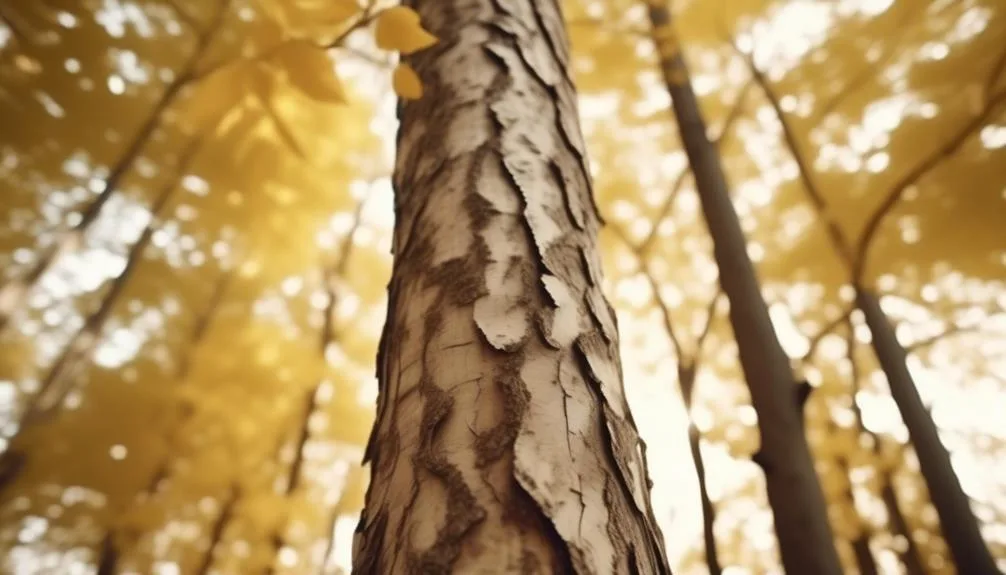Curious about hickory tree growth rates? There's conflicting info out there, but understanding their pace is crucial for cultivators and managers. Factors influencing their development are worth knowing.
Stick around to uncover whether hickory trees are fast or slow growing, and how to support their growth.
Growth Rate of Hickory Trees
Hickory trees grow at a moderate pace, adding about 13 to 24 inches in height per year under optimal conditions. To maintain healthy growth, understanding soil conditions is crucial. Hickory trees thrive in well-drained, slightly acidic soils. If your soil doesn't meet these criteria, consider amending it with organic matter to improve drainage and acidity.
When it comes to pruning techniques, it's essential to remove dead or diseased branches to promote overall tree health. Prune during the dormant season to avoid stressing the tree. Also, don't remove more than 25% of the canopy at once to prevent shock.
Factors Affecting Hickory Tree Growth
To understand the factors influencing the growth of hickory trees, it's essential to consider the impact of sunlight, soil composition, and water availability on their overall development. The soil quality plays a crucial role, as hickory trees thrive in well-draining, fertile soil with a slightly acidic to neutral pH. Climate conditions, including temperature and precipitation, also significantly affect their growth.
Here are some key factors to consider:
- Sunlight: Adequate sunlight is essential for hickory trees to photosynthesize and grow.
- Soil Quality: Well-draining, fertile soil with the right pH level is crucial for optimal hickory tree growth.
- Water Availability: Sufficient water is necessary, especially during the tree's early stages, to support healthy and robust growth.
- Climate Conditions: Temperature and precipitation levels impact the overall health and growth rate of hickory trees.
Comparing Hickory Trees to Other Species
Comparing hickory trees with other species reveals distinctive growth patterns and unique adaptations that set them apart in forest ecosystems. When looking at tree species comparison, hickory trees stand out for their moderate to slow growth rate. In comparison to species like the silver maple or the red oak, hickory trees tend to grow at a slower pace.
While some species may reach maturity and produce seeds in just a few years, hickory trees take a longer time to reach their full height and produce a bountiful harvest of nuts. This growth rate comparison showcases the patience and resilience of hickory trees, as they invest more time in developing strong, durable wood and nutritious nuts, contributing to the diverse tapestry of forest ecosystems.
Maximizing Growth of Hickory Trees
Maximizing the growth of hickory trees involves understanding their unique pace of development and adapting cultivation techniques to promote their resilience and productivity within forest ecosystems. To achieve this, consider the following:
- Pruning Techniques: Regularly prune your hickory trees to remove dead or diseased branches, allowing for better air circulation and sunlight penetration.
- Soil Nutrients: Ensure the soil around your hickory trees is rich in essential nutrients such as nitrogen, phosphorus, and potassium to support healthy growth.
- Mulching: Apply a layer of organic mulch around the base of the trees to retain moisture, regulate soil temperature, and provide a steady release of nutrients.
- Watering: Monitor the moisture levels and water your hickory trees deeply during dry spells to encourage strong root development.
Conclusion: Hickory Trees' Growth Rate
Understanding the growth rate of hickory trees is essential for implementing effective cultivation strategies and maximizing their productivity within forest ecosystems.
Hickory tree growth rate can vary depending on the species and environmental conditions. In optimal conditions, hickory trees can exhibit moderate to fast growth, especially during their early years.
Providing adequate sunlight, well-drained soil, and ample space for root development can promote healthy and vigorous growth. However, it's important to note that hickory trees are generally known for their slow to moderate growth compared to other tree species.
Patience is key when cultivating hickory trees, as they may take several years to reach maturity and achieve their full potential. By understanding and accommodating their growth rate, you can better manage hickory trees within forest environments and ensure their long-term success.
Conclusion
In nurturing hickory trees with ample sunlight, water, and space, you can harness their moderate to fast growth rate to enrich your landscape. Their beauty and value will flourish, offering a rewarding testament to thoughtful care.
How will their growth shape your surroundings?
Happy planting!
Mark Hoffman is a dedicated arborist and tree care specialist with over a decade of experience. His love for trees began when he visited Yosemite National Park as a teenager and was awestruck by the giant sequoias. Mark pursued his passion by studying forestry at Michigan Technological University, where he earned a Bachelor of Science degree.
Since then, he has worked tirelessly in the field of arboriculture, helping to preserve and protect trees in his community. His expertise and dedication have made him a respected leader in the industry and a valuable resource for anyone seeking advice on tree care.
